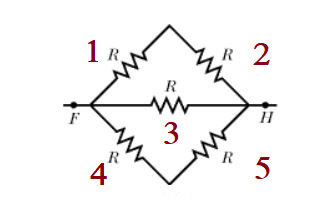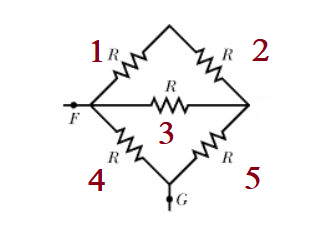Question #210c2
1 Answer
Feb 21, 2018

For resistance between points
There are three branches connected in parallel.
- Series combination of resistors
#1and2=2R# - Resistor
#3=R# - Series combination of resistors
#4and5=2R#
Using the parallel combination formula
#1/R_(eff)=1/(2R)+1/R+1/(2R)#
#=>1/R_(eff)=1/R((1+2+1)/2)#
#=>1/R_(eff)=2/R#
#=>R_(eff)=R/2=6.83/2=3.42\ Omega#

For resistance between points
There are four branches connected as shown in each step.
- Series combination of resistors
#1and2=2R# - Above in parallel with Resistor
#3=R#
Let this be#R_1#
We have#1/R_1=1/(2R)+1/R#
#=>1/R_1=1/R(1/2+1)#
#=>1/R_1=3/(2R)#
#=>R_1=(2R)/3# - Series combination of resistors
#R_1and5=(2R)/3+R=(5R)/3# - Parallel combination of above with resistor
#4# .
Using parallel combination formula we get
#1/R_(eff)=3/(5R)+1/R#
#=>1/R_(eff)=1/R(3/5+1)#
#=>1/R_(eff)=8/(5R)#
#=>R_(eff)=(5R)/8=(5xx6.83)/8=4.27\ Omega#
